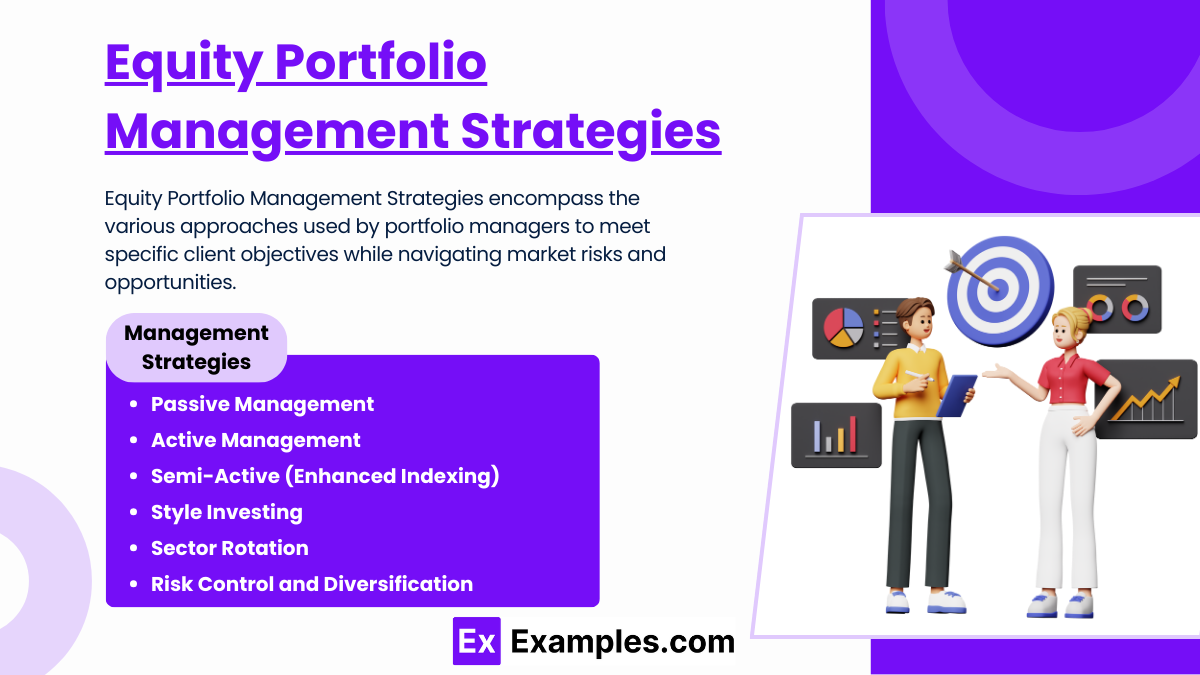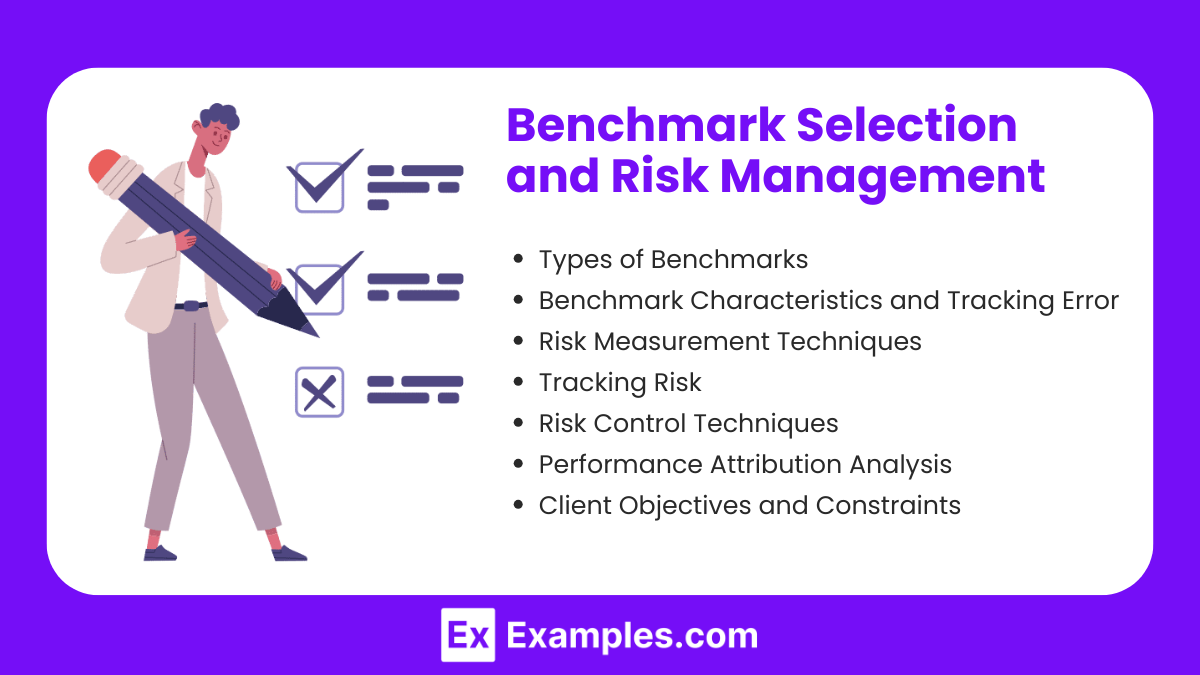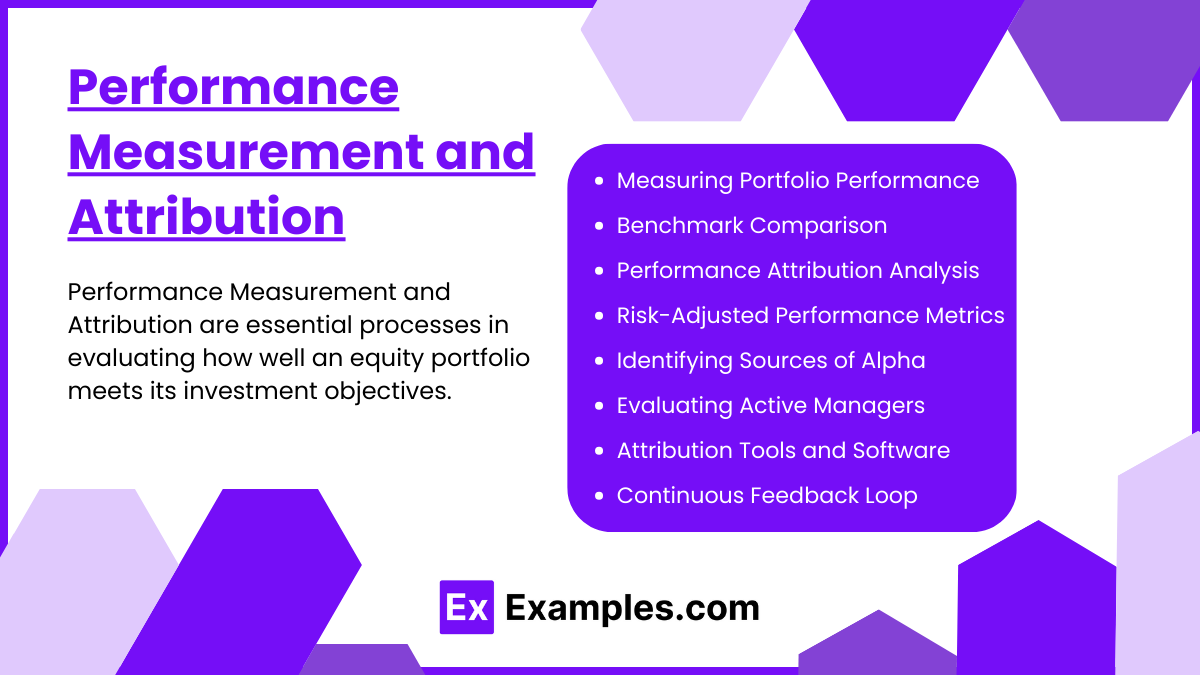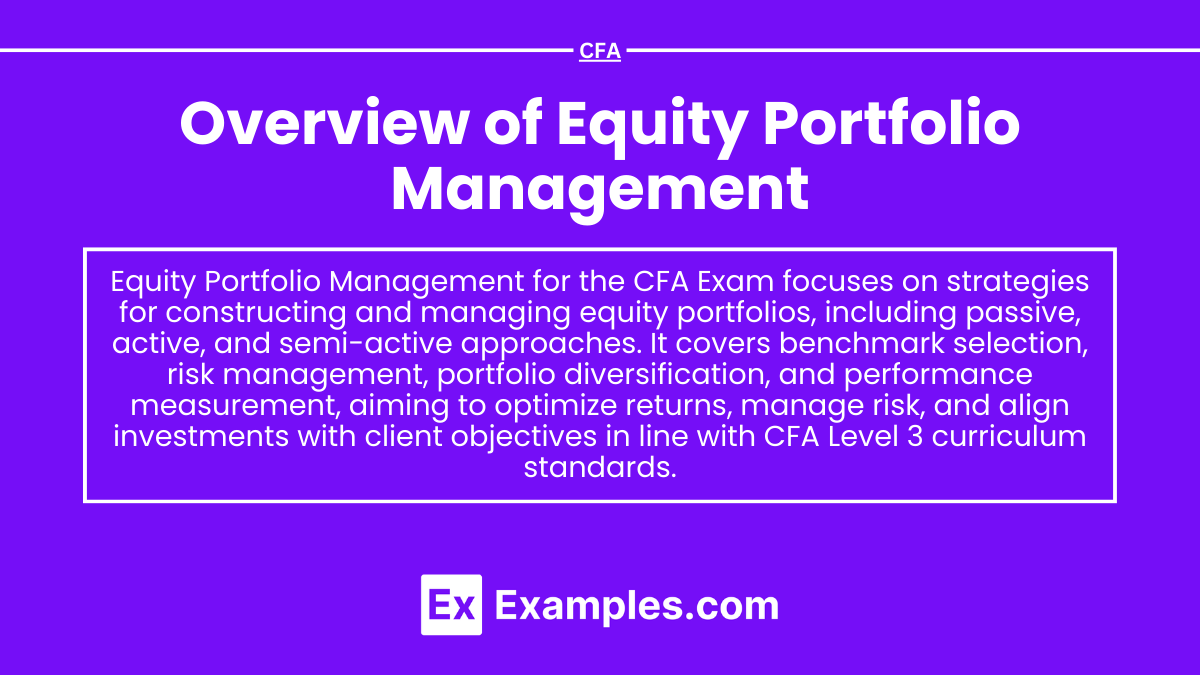Preparing for the CFA Exam requires a solid grasp of Equity Portfolio Management, a core component of investment analysis. Mastery of this topic involves understanding portfolio construction, management strategies, risk control, and performance evaluation. This knowledge is crucial for optimizing equity investments and aligning portfolios with client objectives, market trends, and economic conditions.
Learning Objective
In studying “Overview of Equity Portfolio Management” for the CFA Level 3 Exam, you should understand various strategies for constructing and managing equity portfolios, including passive, active, and semi-active approaches. Analyze factors influencing portfolio design, including investment style, risk tolerance, market trends, and economic considerations. Evaluate approaches for benchmark selection, risk measurement, and performance attribution. Understand the role of diversification, factor exposures, and liquidity in portfolio construction. Additionally, explore strategies like fundamental and quantitative investing, and apply your knowledge to assess equity portfolio decisions and constraints, integrating client objectives and market environments in CFA practice questions and case studies.
Equity Portfolio Management Strategies

Equity Portfolio Management Strategies encompass the various approaches used by portfolio managers to meet specific client objectives while navigating market risks and opportunities. Here are key points explaining these strategies:
1. Passive Management: Passive strategies aim to replicate the performance of a market index, such as the S&P 500. This involves constructing a portfolio that mirrors an index, using methods like full replication or sampling to minimize tracking error.
2. Active Management: Active strategies seek to outperform the market by selecting individual stocks, timing market entries/exits, and leveraging market inefficiencies. Managers conduct fundamental and/or technical analysis to make strategic decisions.
3. Semi-Active (Enhanced Indexing): This approach blends elements of active and passive management. Managers aim to outperform a benchmark with controlled deviations through techniques like factor tilting and modest risk exposure adjustments.
4. Style Investing: Style-based investing involves focusing on specific characteristics, such as growth, value, large-cap, or small-cap stocks. This allows managers to align their strategy with particular risk-return profiles and market conditions.
5. Sector Rotation: Active managers may move investments across different sectors (e.g., technology, healthcare, finance) based on their expectations of economic cycles and sector performance to capture excess returns.
6. Risk Control and Diversification: Effective equity portfolio strategies involve spreading investments across various asset classes, sectors, or regions to mitigate risks and avoid excessive exposure to any single factor.
7. Client Objectives and Constraints: Strategy selection must align with client-specific goals, risk tolerance, investment horizons, tax considerations, and any regulatory restrictions affecting their portfolios.
Benchmark Selection and Risk Management

Benchmark Selection and Risk Management are central to assessing portfolio performance and managing the associated risks to align with investor goals. These concepts ensure a systematic and effective approach to achieving returns within defined risk parameters. Below is an elaboration of the key points:
1. Types of Benchmarks:
Benchmarks are used as a reference for measuring portfolio performance and setting investment goals. Common types include:
- Market Indices: Widely recognized indices like the S&P 500, MSCI World Index, or Russell 2000 serve as benchmarks for specific market segments. These indices provide a broad representation of market performance.
- Custom Benchmarks: Tailored to the unique objectives of a client, these benchmarks are constructed to reflect specific investment guidelines or strategies.
- Peer Group Comparisons: This approach evaluates a portfolio relative to other funds with similar investment strategies, providing insights into relative performance within the same asset class.
2. Benchmark Characteristics and Tracking Error:
An effective benchmark must possess key characteristics to ensure it is a suitable comparison for a portfolio’s performance:
- Relevance and Appropriateness: The benchmark should reflect the portfolio’s investment universe and strategy. For example, a U.S. large-cap equity portfolio should not be benchmarked against a global index.
- Transparency and Investability: Investors must be able to understand and potentially replicate the benchmark. An unclear or overly complex index may lack transparency.
- Tracking Error: This metric measures the deviation of a portfolio’s returns from its benchmark. Low tracking error indicates a close alignment with the benchmark, while high tracking error suggests significant differences due to active management.
3. Risk Measurement Techniques:
Measuring and managing risks is essential to align portfolio outcomes with client expectations. Risk measurement focuses on:
- Market Risk (Beta): Beta measures a portfolio’s sensitivity to market movements. A beta greater than 1 implies higher market volatility, while less than 1 suggests lower volatility.
- Alpha (Excess Return): Alpha assesses the value added by active management above the benchmark return.
- Volatility: Standard deviation of returns, representing the portfolio’s overall risk.
- Factor Risk Exposures: Identifying and controlling exposures to specific risk factors, such as economic, sector, or style factors (e.g., value or growth).
4. Tracking Risk:
Tracking risk is the deviation of portfolio performance relative to the chosen benchmark, often measured by tracking error. This metric is particularly relevant for semi-active and active management strategies:
- Low Tracking Risk: Indicates the portfolio is closely following the benchmark, as is typically the case in passive strategies.
- High Tracking Risk: Suggests a greater deviation due to active investment decisions aimed at outperforming the benchmark, involving higher risk but potential for greater returns.
5. Risk Control Techniques:
Managing risk within equity portfolios is achieved through a range of strategies, including:
- Diversification: Spreading investments across various asset classes, sectors, regions, or individual securities to mitigate unsystematic risk.
- Hedging Strategies: Techniques like options and futures contracts used to limit downside risk.
- Active Risk Controls: Monitoring sector weights, style exposures, and other factors relative to the benchmark to manage deviations in line with the strategy.
6. Performance Attribution Analysis:
This evaluates how well a portfolio’s returns align with or deviate from the benchmark, identifying sources of added value or underperformance through allocation, selection, or interaction effects.
7. Client Objectives and Constraints:
Strategy selection and benchmark alignment must match client goals, risk tolerance, investment horizon, and specific constraints like tax, regulatory, or liquidity needs, ensuring tailored risk management strategies.
Portfolio Construction and Design

Portfolio Construction and Design involve creating an equity portfolio tailored to meet specific client objectives and constraints while navigating market risks and opportunities. This process focuses on building a diversified, well-structured portfolio that balances risk and return. Here is an explanation of key components involved in this process:
1. Investment Style and Approach:
Portfolio managers may choose different investment styles, such as:
- Fundamental Investing: Involves analyzing individual companies based on financial statements, industry trends, management quality, and other qualitative and quantitative factors to select undervalued stocks.
- Quantitative Investing: Uses mathematical models and statistical techniques to identify securities based on patterns, correlations, and quantitative factors, such as momentum, volatility, or mean reversion.
- Style Investing: Includes focusing on specific segments like growth, value, large-cap, or small-cap stocks, which align with particular risk-return profiles and market expectations.
2. Portfolio Diversification:
Diversification is a key risk management technique to spread investments across various asset classes, sectors, regions, or securities, thereby reducing unsystematic risk. A well-diversified portfolio minimizes the impact of negative performance from any single asset or market segment and enhances the potential for stable returns.
3. Asset Allocation:
The allocation of assets within an equity portfolio is driven by client goals, risk tolerance, and market conditions. Effective asset allocation involves:
- Strategic Asset Allocation: Establishing long-term targets for different asset classes based on risk-return objectives.
- Tactical Asset Allocation: Making short-term adjustments to asset allocations in response to market conditions or anticipated economic changes.
4. Factor Exposures:
Portfolio managers must identify and manage exposures to specific factors such as:
- Economic Factors: Interest rates, inflation, GDP growth, etc.
- Market Factors: Market capitalization, sector-specific trends, style factors (e.g., growth vs. value).
- Other Factors: Environmental, social, and governance (ESG) considerations, liquidity constraints, etc. Controlling these exposures allows for better alignment with strategic objectives and risk management goals.
5. Liquidity Considerations:
Liquidity impacts the ease of buying and selling portfolio assets without significantly affecting their prices. Managers need to consider:
- Market Liquidity: The ability to trade assets in large quantities with minimal impact on market prices.
- Client Liquidity Needs: Meeting cash flow requirements for client portfolios, such as withdrawals, expenses, or rebalancing events.
6. Economic and Market Influences:
Portfolio construction must account for macroeconomic and market trends that can affect asset performance. These include economic cycles, changes in interest rates, fiscal and monetary policy shifts, and geopolitical developments.
7. Customization for Client Objectives and Constraints:
Portfolio design must reflect the specific goals, risk tolerance, investment horizon, tax considerations, and legal/regulatory constraints of individual clients. Customization ensures the portfolio aligns with client needs while maintaining an appropriate risk-return balance.
8. Rebalancing and Monitoring:
Continuous monitoring and periodic rebalancing of the portfolio are essential to ensure it remains aligned with strategic goals. Changes in market conditions, asset performance, or client objectives may require adjustments to the portfolio’s composition.
Portfolio Construction and Design is ultimately about finding the right balance between maximizing returns and managing risks, while considering unique client needs and market dynamics. This process requires a deep understanding of financial markets, client constraints, and investment strategies.
Performance Measurement and Attribution

Performance Measurement and Attribution are essential processes in evaluating how well an equity portfolio meets its investment objectives. They provide insights into the sources of portfolio returns, allowing investors and managers to assess the effectiveness of strategies, identify areas for improvement, and refine future investment decisions. Here’s a detailed explanation of these key components:
1. Measuring Portfolio Performance:
Performance measurement involves calculating the return generated by a portfolio over a specific period. This includes:
- Absolute Return: The total return earned by the portfolio without comparison to any benchmark.
- Relative Return: The return of the portfolio compared to a benchmark, such as a market index, to evaluate performance in context.
- Time-Weighted and Money-Weighted Returns: Time-weighted return accounts for external cash flows (e.g., contributions and withdrawals), while money-weighted return considers the impact of timing and amount of cash flows.
2. Benchmark Comparison:
Performance is often evaluated relative to a predefined benchmark that represents a relevant market or segment. This allows managers to gauge whether they added value through active management or merely replicated the market’s performance. Key considerations include the benchmark’s appropriateness and its alignment with the portfolio’s objectives.
3. Performance Attribution Analysis:
Attribution analysis breaks down the portfolio’s returns to understand the sources of outperformance or underperformance relative to the benchmark. It typically involves:
- Asset Allocation Effect: Measures the impact of the manager’s decision to over- or underweight specific asset classes, sectors, or regions compared to the benchmark.
- Security Selection Effect: Evaluates the effect of selecting individual securities within each asset class relative to the benchmark holdings.
- Interaction Effect: Captures the combined impact of asset allocation and security selection, reflecting any additional value generated (or lost) by these decisions.
4. Risk-Adjusted Performance Metrics:
To assess whether the portfolio’s return justifies the level of risk taken, risk-adjusted metrics are used:
- Sharpe Ratio: Measures excess return per unit of risk (volatility), helping compare portfolios with different risk levels.
- Information Ratio: Assesses the consistency of excess return relative to a benchmark, accounting for tracking error.
- Alpha: The excess return of the portfolio compared to the expected return based on its risk (as measured by beta).
5. Identifying Sources of Alpha:
Performance attribution helps identify whether alpha was generated through superior security selection, timing, style-based exposures, or other factors. By pinpointing these sources, managers can refine their strategies to enhance performance and minimize weaknesses.
6. Evaluating Active Managers:
For portfolios managed by third-party or in-house managers, performance evaluation considers their ability to generate excess returns and adhere to their stated investment approach. This involves assessing:
- Consistency of Returns: Whether the manager consistently adds value over different time periods and market conditions.
- Style Drift Analysis: Determining if a manager deviated from their stated investment style, which could indicate changes in risk profile.
7. Attribution Tools and Software:
Advanced attribution tools and software facilitate detailed performance analysis, breaking down returns into multiple dimensions (e.g., sector, geographic, factor-based). This provides greater transparency into the decision-making process and highlights areas where managers succeeded or fell short.
8. Continuous Feedback Loop:
Performance measurement and attribution form a feedback loop, guiding future investment decisions and strategic adjustments. By analyzing past successes and failures, portfolio managers can optimize asset allocation, refine security selection, and align risk management practices with client goals.
Overall, Performance Measurement and Attribution provide a structured approach to evaluating the effectiveness of portfolio management, ensuring that managers remain accountable and capable of delivering value to clients.
Examples
Example 1: Passive Management Strategy
A portfolio manager constructs an equity portfolio to mirror the S&P 500 index by purchasing all 500 component stocks in identical proportions to the index. This passive management approach focuses on achieving similar returns to the market, with low expenses and minimal tracking error, appealing to clients who seek market-matching performance.
Example 2: Active Management Strategy
An equity manager actively selects stocks in the energy sector based on a detailed analysis of market conditions, company fundamentals, and macroeconomic factors. By making strategic trades and adjusting allocations based on changing trends, the goal is to outperform a benchmark index through superior security selection and market timing.
Example 3: Semi-Active (Enhanced Indexing) Strategy
A portfolio employs a semi-active strategy by closely following a broad equity index but incorporates small overweights to undervalued stocks identified through fundamental analysis. The aim is to achieve modest excess returns while maintaining a low tracking error relative to the benchmark, balancing active and passive management.
Example 4: Benchmark Selection and Risk Management
An equity portfolio tailored to emerging markets is benchmarked against the MSCI Emerging Markets Index. The manager monitors tracking error and adjusts holdings as needed to control risk, ensuring the portfolio aligns with client goals while striving to deliver superior returns through strategic asset and country allocations.
Example 5: Diversification for Risk Mitigation
A portfolio is diversified across sectors, industries, and geographic regions to mitigate risk exposure. By investing in a mix of growth and value stocks from different markets, the portfolio aims to reduce unsystematic risk and improve the likelihood of achieving a consistent return profile over time.
Practice Questions
Question 1:
Which of the following best describes the goal of a passive equity portfolio management strategy?
A) Achieving returns higher than a market index by selective stock picking
B) Minimizing transaction costs and matching the returns of a specified market index
C) Outperforming a benchmark index through tactical asset allocation
D) Reducing market risk by investing in a mix of bonds and equities
Answer: B) Minimizing transaction costs and matching the returns of a specified market index
Explanation:
Passive equity portfolio management seeks to replicate the performance of a market index, such as the S&P 500, by holding all or a representative sample of the index’s constituent stocks. The primary goal is to achieve returns that match the index’s performance with minimal cost and tracking error, rather than outperform it through active selection.
Question 2:
In active equity portfolio management, a manager seeks to generate excess returns primarily through:
A) Fully replicating an index to minimize deviations
B) Selecting securities based on fundamental analysis and market timing
C) Keeping tracking error as low as possible
D) Adhering to a fixed asset allocation strategy
Answer: B) Selecting securities based on fundamental analysis and market timing
Explanation:
Active management involves making investment decisions based on research, analysis, and market forecasts to achieve returns that outperform a benchmark index. This strategy typically includes selecting individual stocks, market timing, and other strategies that deviate from the index’s holdings.
Question 3:
The primary purpose of diversification in equity portfolio management is to:
A) Concentrate investments in a few high-performing sectors
B) Increase portfolio exposure to individual stock volatility
C) Spread investments to reduce unsystematic risk
D) Match the returns of a market index
Answer: C) Spread investments to reduce unsystematic risk
Explanation:
Diversification reduces unsystematic risk (risk specific to individual assets or sectors) by spreading investments across different asset classes, industries, or geographic regions. This approach aims to mitigate the impact of poor performance by any single investment, enhancing the portfolio’s overall risk-return profile.


